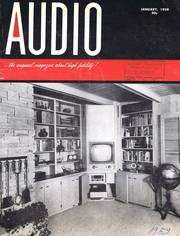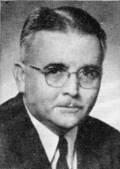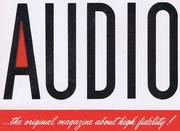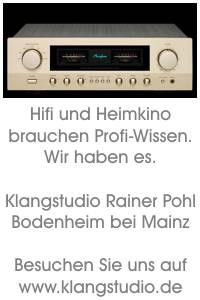Erläuterungen zu diesen US-AUDIO Seiten der 1950er Jahre
Die hier stehenden amerikanischen Artikel aus 1959 (aus der US-AUDIO) sind teilweise sehr gewöhnungsbedürftig, weil sie erstens aus einer längst vergangenen Zeit stammen und zweitens, weil dort in den USA ganz "anders" gedacht wurde als bei uns in Old Germany oder in Europa.
Vergleichbar mit unseren deutschen Hifi-Magazinen etwa ab 1962 ist jedoch, daß auch dieses Audio-Magazin ihre Anzeigen- Kunden und -Leser am Markt oder von anderen Magazinen (be- oder ab- ?) werben mußte. - Weiterhin sind die riesigen Dimensionen des amerikanischen Kontinents mit unseren hier in Europa nicht vergleichbar. - Ein Redaktions-"Trip" von New York nach Los Angeles oder Chicago oder gar in die Wüste nach Las-Vegas zu einer der CES- Audio- "Shows" war - auch mit dem Flugzeug - immer noch eine halbe Weltreise. Und jede Ausstellung oder "Messe" wurde als "Show" deklariert. Und natürlich, in USA musste alles "Show" sein, um beim Publikum einige Aufmerksamkeit zu erzeugen.
.
Hier zur Einführung in diese 1959er Ausgaben der US-AUDIO etwas mehr als nur das Editorial:
.
. . . . . kommt jetzt auf jeweils eigenen Seiten. Es ist hoch- interessant, was damals bereits an Hifi- und Music-Wissen bekannt war und worüber man diiskutierte und woran entwickelt wurde.
.
Die monatliche Kolumne - Editors' REVIEW - das Editorial
. . . . . kommt jetzt auf jeweils eigenen "REVIEW"- (Editorial-) Seiten. Ganz oben auf jeder dieser Seiten können Sie zum nächsten Editorial blättern.
Es geht los - Ein interessanter Artikel über die kommende amerikanische UKW (FM) Stereo Technik :
"EDITOR'S REVIEW" (AUDIO • JAN. 1959)
von C. G. McProud, Editor and Publisher -
über das Thema :
"OUTLOOK FOR 1959" (= "stereo broadcasting")
As we enter the new year, the one important problem awaiting solution is that of stereo broadcasting. That it will come is almost certain - in what form and when are still up in the air, awaiting FCC determination. Principal contenders in the stereo hassle are the systems known as the Crosby and the Halstead - both using FM multiplex, but in different manners. We still believe that a compromise would provide an amicable solution, though the Crosby partisans insist that it would degrade quality or decrease the stereo service area, or both.
Last month, ECA first and Philco later made proposals which will undoubtedly further delay any final determination, although it would seem possible that whatever is done in the FM/multiplex system need not be influenced by counter proposals involving only AM, as the RCA and Philco methods do.
We have no details of the latter (letzteres) system, but RCA's proposal suggests the separate use of the two sidebands of an AM carrier with each modulated by one of the channels. As presented in the publicity releases, it would appear that RCA thought this to be a new and radically novel suggestion. (Es entpuppte sich als Irrtum, die FCC hatte sich im April 1961 für ein besseres System entschieden.)
.
We think differently.
As proof, we quote directly the last item in the Editor's Report in the August, 1951, issue of Audio Engineering:
.
- "One reader, Milton Sackin, writes to suggest the use of two channels of transmission to provide stereophonic sound in the home. These two channels could readily be transmitted over the stations which have both AM and FM facilities, and listeners with two receivers and two speakers could then receive sound which should be more realistic than that from a single channel.
- "While the idea is not new - having been tried in Holland some years ago - we admit to having attempted to "sell" the idea to one of the New York stations with both outlets. Station agreed, program producer demurred.
- "On the same subject - what is wrong with this idea? Two separate channels, fed by suitably spaced microphones, are used to modulate the positive and negative halves, respectively, of an AM carrier. Ordinary receivers using half-wave diode detectors would reproduce the output of one channel or the other, but since the microphones are reasonably close together there should not be much difference in the resulting sound. Stereo receivers would have two half-wave detectors, of opposite polarity, followed by separate audio and speaker systems. Thus no changes would be required in existing sets unless a listener wanted the additional advantage of stereo reproduction.
- "One of the precepts of good engineering is that no equipment should be obsoleted by a change of standards. In view of recent color TV decisions, it appears that all standard-making agencies are not in agreement with this precept. We would, however, like to hear some experimental work on a dual-channel transmission."
.
AM/FM stereo broadcasting - ist ein alter Hut.
As we now know, of course, AM/FM stereo broadcasting is "old hat" today, and many stations are doing it on a regular basis. We also know that we would revise parts of the earlier suggestion relative to reception of only one channel being satisfactory. However, any full-wave detector would provide a sum signal of both channels. Single-sideband transmission is not impossible, as we know, and we still believe that both sidebands could be transmitted with separate modulation on the two halves.
Apparently RCA believes so, too, but we wish the experimental work could have been started some years ago - by now we would have stereo broadcasting, even though the FM/multiplex system is probably better in quality.
Calbest Electronics has proposed a system in which only the important stereo range components are transmitted by multiplex, the main channel - as in the Crosby system - transmitting the "sum" signal.
Since the full audio spectrum is not necessary to establish direction, according to Calbest, this would permit the use of narrow-band FM-multiplex for the stereo-information channel, which would conserve channel bandwidth. It would seem as though there is considerable merit in this system, and we would like to hear it in actual engineering tests.
But - and here's the rub - this means more delay. Why not allow more experimentation, using all proposed systems? With the necessary availability of receivers the public could decide, even if the proposing companies had to provide, say, 1000 receivers at no cost for field-trial purposes.
One thing about hi-fi - it is never dull (langweilig).
.
Ein typisch amerikanischer Artikel :
"audiofacts" - The case of the vanishing ghost -
oder die unerwünschten Echos bei Studio-Tonbändern.
.
- Anmerkung : Entweder war es in den USA nicht bekannt oder man wollte es gar nicht wissen, bei der deutschen AGFA und der BASF in der Broadcast- (Rundfunk-) Abteilung war es sehr wohl bekannt, wie diese Echos entstehen und wie man sie beseitigen kann. Schaun Sie mal in das AGFA-Büchlein von Herrn Singhoff rein. Er hat sehr gut beschrieben, womit sie sich bei AGFA Professional rumgequält hatten.
.
To the TV viewer, a "ghost" is a faint, unwanted image, slightly displaced from the main picture. But although many home recordists are not aware of it, tape recording has its phantoms, too. In this case the "ghost" is a faint sound or "echo," displaced from the main signal.
The audio engineer, who is very sensitive to even the slightest imperfections in recorded sound, calls this print-through - the magnetic echo that is induced from one layer of tape to the next on recorded tapes during storage. These print-through signals increase gradually with time and are accelerated by unfavorable storage conditions. Eventually, they can build up to annoying proportions.
Audio Devices engineers have been working on this problem for several years and have come up with two very effective solutions which can be used separately or in combination, to dispel the elusive "ghosts" of tape recording.
The first solution, pioneered by Audio Devices and announced to the trade last year, was the introduction of a new tape formulation which is highly impervious to print-through. This Master Audiotape reduces print-through by 8db compared to ordinary tape - making it entirely negligible to even the most critical ear after years of storage.
The second solution, first "unveiled" at the Audio Show in New York, is the new Audio "ECHORASER", a simple, inexpensive device which attaches to a tape recorder and removes up to 9db of print-through from any recorded tape without affecting the recorded signals. Mounted between the supply reel and playback heads, it automatically wipes off the echo while the tape is being played back - adding new brilliance and clarity and reducing background noise.
For complete information on this new development, write to Dept. AA, Audio Devices, Inc., 444 Madison Avenue, New York 22, N. Y. Ask for Bulletin 500.
AUDIO • JANUARY, 1959 - THE SPRING SHOWS
This month we have the Rigo show in Minneapolis, from the 16th to the 18th (1959). In February 1959 we have three - Washington, D.C., San Francisco, and Los Angeles - the latter being the largest outside of New York. Largest in exhibitors, at least, even if not in attendance. We wonder how long this balance will continue.
The Washington show is at the Shoreham Hotel from February 5-8. 1959; San Francisco's is at the Cow Palace, February 6-9. 1959 (try to get to both of them, huh?) and Los Angeles' event is again at the Biltmore Hotel, February 16-23. 1959.
Aus der Feb. Ausgabe : COMING HiFi SHOWS
AUDIO • FEBRUARY, 1959
Feb. 5-8 - Washington, D. C.; International High Fidelity Music Festival of 1959, Shoreham Hotel. {Independent)
Feb. 7-10 - San Francisco, Cal.; Cow Palace. (IHFM, Northern Cal. Audio Shows, Inc.)
Feb. 17-23 - Los Angeles, Cal.; Biltmore. (IHFM)
Mar. 6-8 - Denver, Colo.; Cosmopolitan. (Rigo)
Aus der März Ausgabe : COMING HiFi SHOWS
March 6-8 - Denver, Colo. Cosmopolitan Hotel, (Rigo)
March 20-22 - Baltimore, Md. Lord Baltimore Hotel. (Rigo)
April 2-5 - Fourth London Audio Fair, Russell Hotel, London, W.C.I, England.
April 3-5 - Pittsburgh, Pa. Penn-Sheraton Hotel. (Rigo)
October 5-10 - New York High Fidelity Show, Trade Show Building. (IHFM)
OTHER EVENTS in 1959
March 15-18 - Annual Convention, National Association of Broadcasters. Conrad Hilton Hotel, Chicago, I11.
March 23-26 - National Convention, Institute of Radio Engineers. The Coliseum and Waldorf-Astoria Hotel, New York.
April 6-9 - Radio Electronic Components Manufacturers' Federation show. Great Hall, Grosvenor House, London, England.
Aus der August Ausgabe : COMING HiFi SHOWS
Sept. 11-13 - Milwaukee, Pfister Hotel. (Rigo)
Sept. 18-20 - Chicago, 8th Annual High Fidelity Show and Music Festival, Palmer House, (International Sight and Sound Exposition, Inc.)
Sept, 25-27 - Rochester, N. Y., Sheraton Hotel. (Rigo)
Oct. 5-10 - New York, High Fidelity Music Show, New York Trade Show Building. Presented by the "Institute of High Fidelity Manufacturers", with "Decorate your home with music" as the theme. (IHFM)
Oct. 30-Nov. 1 - Buffalo, N. Y., Statler Hotel. (Rigo)
Nov. 6-8 - Seattle, Wash., New Washington Hotel. (Rigo)
Nov. 13-15 - Portland, Ore., New Heath-man Hotel. (Rigo)
Nov. 20-22 - Philadelphia, Benjamin Franklin Hotel. (Rigo)
Jan. 27-31-1960 - San Francisco, Brooks Hall. (IHFM)
Feb. 10-14-1960 - Los Angeles, Shrine Exposition Hall. (IHFM)





